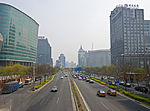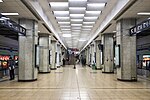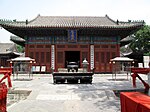Chaowai Subdistrict
Chaoyang District, BeijingSubdistricts of Beijing

Chaowai Subdisrict (Chinese: 朝外街道; pinyin: Cháowài Jiēdào) is a subdistrict inside Chaoyang District, Beijing, China. It is bordering Sanlitun and Dongzhimen Subdistricts to the north, Hujialou Subdistrict to the east, Jianwai Subdistrict to the south, Dongsi, Chaoyangmen and Jianguomen Subdistricts to the west. Tt has a total population of 33,212 as of the 2020 census.The name of this subdistrict refers to the area to the east (i.e. "outside" of) Chaoyangmen Gate of Ming city wall.
Excerpt from the Wikipedia article Chaowai Subdistrict (License: CC BY-SA 3.0, Authors, Images).Chaowai Subdistrict
三丰路, Chaoyang District Chaowai (朝外街道)
Geographical coordinates (GPS) Address Nearby Places Show on map
Geographical coordinates (GPS)
| Latitude | Longitude |
|---|---|
| N 39.9195 ° | E 116.4317 ° |
Address
三丰路
三丰路
100004 Chaoyang District, Chaowai (朝外街道)
Beijing, China
Open on Google Maps









